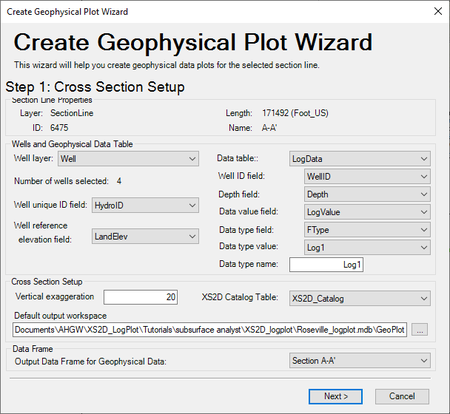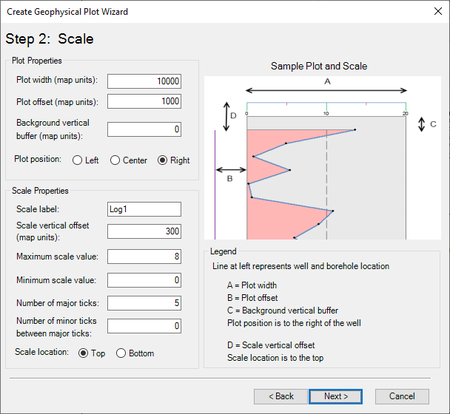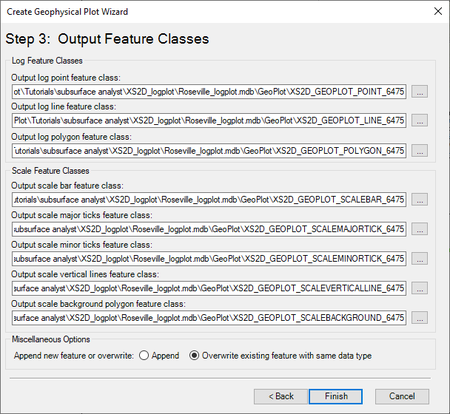AHGW:Create Geophysical Plot Wizard (Section Line): Difference between revisions
From XMS Wiki
Jump to navigationJump to search
No edit summary |
No edit summary |
||
| Line 1: | Line 1: | ||
{{TOC right}} | {{TOC right}} | ||
==ArcGIS Notes== | |||
The ''Create Geophysical Plot Wizard'' dialog for section lines is accessed by clicking [[File:AHGW Geophysical Plot Icon.png]] '''Create Geophysical Plot''' (for cross sections) on the [[AHGW:Arc Hydro Groundwater Toolbar|Arc Hydro Groundwater Toolbar]]. This tool helps create geophysical data plots for the selected section lines in [[ArcGIS]]. | The ''Create Geophysical Plot Wizard'' dialog for section lines is accessed by clicking [[File:AHGW Geophysical Plot Icon.png]] '''Create Geophysical Plot''' (for cross sections) on the [[AHGW:Arc Hydro Groundwater Toolbar|Arc Hydro Groundwater Toolbar]]. This tool helps create geophysical data plots for the selected section lines in [[ArcGIS]]. | ||
==Cross Sections== | ===Cross Sections=== | ||
When [[File:AHGW Geophysical Plot Icon.png]] '''Create Geophysical Plot''' is clicked, the wizard contains the following steps: | When [[File:AHGW Geophysical Plot Icon.png]] '''Create Geophysical Plot''' is clicked, the wizard contains the following steps: | ||
*Step 1: Cross Section Setup | *Step 1: Cross Section Setup | ||
| Line 8: | Line 9: | ||
*Step 3: Output Feature Classes | *Step 3: Output Feature Classes | ||
===Cross Section Setup=== | ====Cross Section Setup==== | ||
[[File:AHGW-CreateGeophysicalPlotWizard1.png|thumb|450 px|Step 1 of the ''Create Geophysical Plot Wizard'']] | [[File:AHGW-CreateGeophysicalPlotWizard1.png|thumb|450 px|Step 1 of the ''Create Geophysical Plot Wizard'']] | ||
The following sections, options, and fields are available: | The following sections, options, and fields are available: | ||
| Line 37: | Line 38: | ||
*'''Cancel''' – Cancels any changes and exits the ''Create Geophysical Plot Wizard'' dialog. | *'''Cancel''' – Cancels any changes and exits the ''Create Geophysical Plot Wizard'' dialog. | ||
===Scale=== | ====Scale==== | ||
[[File:AHGW-CreateGeophysicalPlotWizard2.png|thumb|450 px|Step 2 of the ''Create Geophysical Plot Wizard'']] | [[File:AHGW-CreateGeophysicalPlotWizard2.png|thumb|450 px|Step 2 of the ''Create Geophysical Plot Wizard'']] | ||
This step defines the plot and scale properties. The following sections, options, and fields are available: | This step defines the plot and scale properties. The following sections, options, and fields are available: | ||
| Line 59: | Line 60: | ||
*'''Cancel''' – Cancels any changes and exits the ''Create Geophysical Plot Wizard'' dialog. | *'''Cancel''' – Cancels any changes and exits the ''Create Geophysical Plot Wizard'' dialog. | ||
===Output Feature Classes=== | ====Output Feature Classes==== | ||
[[File:AHGW-CreateGeophysicalPlotWizard3.png|thumb|450 px|Step 3 of the ''Create Geophysical Plot Wizard'']] | [[File:AHGW-CreateGeophysicalPlotWizard3.png|thumb|450 px|Step 3 of the ''Create Geophysical Plot Wizard'']] | ||
This step defines the output feature classes. The following sections, options, and fields are available: | This step defines the output feature classes. The following sections, options, and fields are available: | ||
Revision as of 20:22, 9 January 2024
ArcGIS Notes
The Create Geophysical Plot Wizard dialog for section lines is accessed by clicking ![]() Create Geophysical Plot (for cross sections) on the Arc Hydro Groundwater Toolbar. This tool helps create geophysical data plots for the selected section lines in ArcGIS.
Create Geophysical Plot (for cross sections) on the Arc Hydro Groundwater Toolbar. This tool helps create geophysical data plots for the selected section lines in ArcGIS.
Cross Sections
When ![]() Create Geophysical Plot is clicked, the wizard contains the following steps:
Create Geophysical Plot is clicked, the wizard contains the following steps:
- Step 1: Cross Section Setup
- Step 2: Scale
- Step 3: Output Feature Classes
Cross Section Setup
The following sections, options, and fields are available:
- Section Line Properties section – Not user editable in this dialog. Displays the following properties
- Layer – The name of the layer.
- ID – The section line ID.
- Length – The length of the selected section line.
- Name – The name of the selected section line.
- Wells and Geophysical Data Table section
- Well Layer – Select the desired well layer from the drop-down.
- Number of wells selected – The number of wells currently selected.
- Well unique ID field – Select from the drop-down the unique ID field to use.
- Well reference elevation field – Select from the drop-down the well reference elevation field to use.
- Data table – Select the data table from the drop-down.
- Well ID field – Select the well ID field from the drop-down.
- Depth field – Select the depth field from the drop-down.
- Depth value field – Select the depth value field from the drop-down.
- Depth type field – Optional. Select the data fype field from the drop-down.
- Data type value – Required if Data type field ise set. Select an additional data type field from the drop-down.
- Data type name – Required if Data type field and Data type value are set. Enter a name for the data type.
- Cross Section Setup section
- Vertical exaggeration – Enter a decimal value for the vertical exaggeration.
- XS2D Catalog Table – Select the XS2D catalog from the drop-down.
- Default output workspace – Displays the absolute path to a default output workspace. Click
 to bring up the Select Output Workspace dialog where a workspace can be designated.
to bring up the Select Output Workspace dialog where a workspace can be designated.
- Data Frame section
- Output Data Frame for Geophysical Data – Select the output data frame from the drop-down. In addition to "<Create new data frame>", other available data frames will be listed in the drop-down.
- Next – Switches to the second page of the Create Geophysical Plot Wizard dialog.
- Cancel – Cancels any changes and exits the Create Geophysical Plot Wizard dialog.
Scale
This step defines the plot and scale properties. The following sections, options, and fields are available:
- Plot Properties section – Values are in the units defined for the map (feet, meters, etc.).
- Plot width – Enter a decimal value.
- Plot offset – Enter a decimal value.
- Background vertical buffer – Enter a decimal value.
- Plot position – Select the desired radio button: Left, Center, or Right.
- Scale Properties section
- Scale label – Enter an alphanumeric label for the scale feature.
- Scale vertical offset – Enter a decimal value.
- Maximum scale value – Enter an integer for the maximum value for the scale.
- Minimum scale value – Enter an integer for the minimumvalue for the scale.
- Number of major ticks – Enter an integer for the number of major ticks on the scale bar.
- Number of minor ticks between major ticks – Enter an integer for the number of minor ticks between each set of major ticks on the scale bar.
- Scale location – Select the radio button indicating the location for the scale bar: Top or Bottom.
- Sample Plot and Scale section – Displays a sample plot and scale to be used with the information in the Legend section.
- Legend section – Explanation of the content of the Sample Plot and Scale section.
- Back – Switches back to the first page of the Create Geophysical Plot Wizard dialog.
- Next – Switches to the third page of the Create Geophysical Plot Wizard dialog.
- Cancel – Cancels any changes and exits the Create Geophysical Plot Wizard dialog.
Output Feature Classes
This step defines the output feature classes. The following sections, options, and fields are available:
- Log Feature Classes section
- Output log point feature class – Click
 to bring up the Save Log Point Features As dialog where a new feature class can be entered and saved.
to bring up the Save Log Point Features As dialog where a new feature class can be entered and saved. - Output log line feature class – Click
 to bring up the Save Log Line Features As dialog where a new feature class can be entered and saved.
to bring up the Save Log Line Features As dialog where a new feature class can be entered and saved. - Output log polygon feature class – Click
 to bring up the Save Log Polygon Features As dialog where a new feature class can be entered and saved.
to bring up the Save Log Polygon Features As dialog where a new feature class can be entered and saved.
- Output log point feature class – Click
- Scale Feature Classes section
- Output scale bar ticks feature class – Click
 to bring up the Save Scale Bar Features As dialog where a new feature class can be entered and saved.
to bring up the Save Scale Bar Features As dialog where a new feature class can be entered and saved. - Output scale major ticks feature class – Click
 to bring up the Save Scale Major Ticks Features As dialog where a new feature class can be entered and saved.
to bring up the Save Scale Major Ticks Features As dialog where a new feature class can be entered and saved. - Output scale minor ticks feature class – Click
 to bring up the Save Scale Minor Ticks Features As dialog where a new feature class can be entered and saved.
to bring up the Save Scale Minor Ticks Features As dialog where a new feature class can be entered and saved. - Output scale vertical lines feature class – Click
 to bring up the Save Scale Vertical Lines Features As dialog where a new feature class can be entered and saved.
to bring up the Save Scale Vertical Lines Features As dialog where a new feature class can be entered and saved. - Output scale background polygon feature class – Click
 to bring up the Save Scale Background Polygon Features As dialog where a new feature class can be entered and saved.
to bring up the Save Scale Background Polygon Features As dialog where a new feature class can be entered and saved.
- Output scale bar ticks feature class – Click
- Miscellaneous Options section
- Append new feature or overwrite – Select the radio button indicating whether new features should be appended to the existing features (Append) or whether the existing features should be overwritten (Overwrite existing feature with same data type).
- Back – Switches back to the second page of the Create Geophysical Plot Wizard dialog.
- Finish – Saves any changes and exits the Create Geophysical Plot Wizard dialog.
- Cancel – Cancels any changes and exits the Create Geophysical Plot Wizard dialog.



